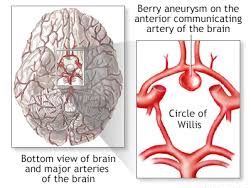| What is a brain aneurysm? A brain aneurysm is a swollen bulge or “ballooning” in the wall of a blood vessel in the brain . A small aneurysm often causes no symptoms. But if it grows, an aneurysm can press on nerves inside your brain, causing pain and other symptoms. It can also leak blood or burst, causing a sudden, severe headache. A burst aneurysm is a very serious, life-threatening emergency that needs to be treated right away. It leads to a bleeding (hemorrhagic) stroke. Stroke is the term doctors use when a part of the brain is damaged because of a problem with blood flow. The stroke that happens after a brain aneurysm bursts is called a “subarachnoid hemorrhage.” What are the symptoms of a brain aneurysm? Most small brain aneurysms cause no symptoms and are found during an imaging test (which a doctor does to look at pictures of a person’s brain). For example, a person might get an imaging test because a family member had an aneurysm, or for an unrelated reason. But a large aneurysm can cause symptoms that include: ●A bad headache ●Pain in the face ●Blurry or double vision If the aneurysm bursts, symptoms can include: ●A sudden, severe headache – People often say the headache is the worst they have ever had. ●A stiff neck ●Nausea and vomiting ●Passing out Are there tests for a brain aneurysm? Yes. If you have symptoms of a brain aneurysm, or if you are at risk of having one, your doctor might do several different tests, including: ●Imaging tests – These tests include a CT scan and an MRI. Both show pictures of your brain. During these tests, you might also get an injection of a dye that makes it easier for doctors to see blood flow in the brain. ●Lumbar puncture (sometimes called a “spinal tap”) – During this procedure, a doctor puts a needle into your lower back and takes out a small sample of spinal fluid. Spinal fluid is the fluid that surrounds the brain and spinal cord. If this fluid has more red blood cells than usual, you could have a subarachnoid hemorrhage. ●Cerebral angiogram – For this test, your doctor puts a thin, plastic tube into a large blood vessel, usually near the top of your thigh. Then he or she will advance the tube through your blood vessels past your heart to your brain. Your doctor then injects dye that shows up on an X-ray. This lets the doctor see the blood vessels in your brain and find the aneurysm. How is a brain aneurysm treated? There are 2 main ways to treat a brain aneurysm: ●Surgical clipping – In this surgery, your doctor puts a tiny metal clip on the base of the aneurysm to stop the blood flow to it. ●Endovascular coiling – The first part of this treatment is like a cerebral angiogram (see above). But instead of injecting dye into the tube, your doctor advances a soft wire up through your blood vessels into the aneurysm. The wire coils up inside the aneurysm and seals it off from the blood vessel. If your aneurysm is leaking or bursts, your doctor will do one of these treatments right away. If it has not burst, you might not be treated. The decision depends on the size of the aneurysm, your age, and whether you have other health problems. Whether or not your aneurysm is treated, your doctor will likely do more imaging tests over time. This is to make sure the aneurysm isn’t growing or coming back, and that new aneurysms aren’t forming. Are there things that make people more likely to have a brain aneurysm? Yes. Having a parent, brother, or sister who had an aneurysm makes you more likely to have one. People with certain medical conditions also have a higher risk of aneurysm than other people. Other things that can raise your chances include: ●Having high blood pressure ●Smoking cigarettes ●Drinking too much alcohol ●Using illegal drugs, such as cocaine or amphetamines ●Taking diet pills Avoiding these things might help lower your chance of getting an aneurysm. |
